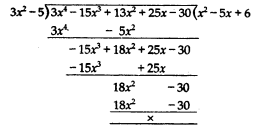Ask questions which are clear, concise and easy to understand.
Ask QuestionPosted by Prince Raj 6 years, 4 months ago
- 2 answers
Posted by Sonu Sahu 6 years, 4 months ago
- 1 answers
Posted by Rani Patil 6 years, 3 months ago
- 1 answers
Sia ? 6 years, 3 months ago
We have the polynomial f(x) = (3x4 - 15x3 + 13x2 + 25x - 30).
Since {tex}\sqrt { \frac { 5 } { 3 } } \text { and } - \sqrt { \frac { 5 } { 3 } }{/tex} are the zeros of f(x),
i.e., {tex}x=-\sqrt{\frac53}{/tex} and {tex}x=\sqrt{\frac53}{/tex}
i.e., {tex}x+\sqrt{\frac53}=0\;and\;x-\sqrt{\frac53}=0{/tex} so it follows that each
one of {tex}\left( x - \sqrt { \frac { 5 } { 3 } } \right) \operatorname { and } \left( x + \sqrt { \frac { 5 } { 3 } } \right){/tex} is a factor of f(x).so using {tex}\left(a+b\right)\left(a-b\right)=a^2-b^2{/tex}, we get
{tex}\therefore \quad \left( x - \frac { \sqrt { 5 } } { \sqrt { 3 } } \right) \left( x + \frac { \sqrt { 5 } } { \sqrt { 3 } } \right) = 0 \Rightarrow \left( x ^ { 2 } - \frac { 5 } { 3 } \right)= 0 \Rightarrow \frac { \left( 3 x ^ { 2 } - 5 \right) } { 3 }= 0{/tex} is also a factor of f(x).
Consequently, (3x2 - 5) is a factor of f{x).
On dividing the polynomial by (3x2 - 5), we get

{tex}\therefore{/tex} f(x) = 3x4 - 15x3 + 13x2 + 25x - 30
= (3x2 - 5 )(x2 - 5x + 6).
By middle term factorisation. We get,
={tex}\left(3x^2-5\right)\left(x^2-2x-3x+6\right){/tex}
=({tex}\lbrack(\sqrt{3x})^2-\left(\sqrt5\right)^2\rbrack{/tex}{tex}\left[x\left(x-2\right)-3\left(x-2\right)\right]{/tex}
By using {tex}a^2-b^2=\left(a+b\right)\left(a-b\right){/tex}we get,
{tex}= ( \sqrt { 3 } x + \sqrt { 5 } ) ( \sqrt { 3 } x - \sqrt { 5 } ) ( x - 2 ) ( x - 3 ){/tex}
{tex}\therefore{/tex} f(x) = 0 , so either factors can equated to zero to get the roots {tex}\Rightarrow ( \sqrt { 3 } x + \sqrt { 5 } ) = 0 \text { or } ( \sqrt { 3 } x - \sqrt { 5 } ) = 0{/tex}
{tex}\Rightarrow{/tex}(x - 2) = 0 or (x - 3) = 0
{tex}\Rightarrow x = - \sqrt { \frac { 5 } { 3 } } \text { or } x = \sqrt { \frac { 5 } { 3 } }{/tex} or x = 2 or x = 3
Hence, we get all zeros of f(x) are {tex}\sqrt { \frac { 5 } { 3 } } , - \sqrt { \frac { 5 } { 3 } }{/tex}, 2 and 3.
Posted by Nagappa Talawar 6 years, 4 months ago
- 0 answers
Posted by Akash Lal 6 years, 4 months ago
- 3 answers
Posted by Rithin Smart 6 years, 4 months ago
- 2 answers
Prince Raj 6 years, 4 months ago
Posted by Vaishali Wani 6 years, 4 months ago
- 2 answers
Posted by Mansi Sengar 6 years, 4 months ago
- 2 answers
Mansi Sengar 6 years, 4 months ago
Akash Lal 6 years, 4 months ago
Posted by Smriti Mishra 6 years, 4 months ago
- 0 answers
Posted by Tanya Suryavanshi 6 years, 4 months ago
- 16 answers
Tanya Suryavanshi 6 years, 4 months ago
Pk . 6 years, 4 months ago
Pk . 6 years, 4 months ago
Pk . 6 years, 4 months ago
Tanya Suryavanshi 6 years, 4 months ago
Tanya Suryavanshi 6 years, 4 months ago
Posted by Amit Singh 6 years, 4 months ago
- 1 answers
?Niharika Sharma ? 6 years, 4 months ago
Posted by Motivation Training 6 years, 4 months ago
- 1 answers
Posted by Harsh Choudhary Harsh Choudhary 6 years, 3 months ago
- 1 answers
Sia ? 6 years, 3 months ago
Since {tex}(3y-1), (3y+5)\ and\ (5y+1){/tex} are in AP, we have
{tex}(3y+5)-(3y-1)=(5y+1)-(3y+5){/tex}
{tex} \Rightarrow {/tex} {tex}3y+5-3y+1=5y+1-3y-5{/tex}
{tex} \Rightarrow {/tex} {tex}6=2y-4{/tex}
{tex} \Rightarrow {/tex} 2y=10
{tex} \Rightarrow {/tex} y=5
Posted by Saurabh Pathak 6 years, 4 months ago
- 1 answers
Janu Likki 6 years, 4 months ago
Posted by Viraj Thekdi 6 years, 4 months ago
- 0 answers
Posted by Jhuma Moitra 6 years, 4 months ago
- 0 answers
Posted by Abh!Shek Mourya 6 years, 4 months ago
- 1 answers
__Richa Tiwari 6 years, 4 months ago
Posted by Joel Emil 6 years, 4 months ago
- 2 answers
__Richa Tiwari 6 years, 4 months ago
Nikhil Raj 6 years, 4 months ago
Posted by Saloni Singh 6 years, 4 months ago
- 0 answers
Posted by Kailash Yadav 6 years, 4 months ago
- 2 answers
Gaurav Seth 6 years, 4 months ago
A polynomial looks like this:
 |
| example of a polynomial this one has 3 terms |
Polynomial comes from <i>poly-</i> (meaning "many") and <i>-nomial</i> (in this case meaning "term") ... so it says "many terms"
A polynomial can have:
| constants (like 3, −20, or ½) |
| variables (like <i>x</i> and <i>y</i>) |
| exponents (like the 2 in y2), but only 0, 1, 2, 3, ... etc are allowed |
Pk . 6 years, 4 months ago
Posted by Rama S Rama S 6 years, 4 months ago
- 1 answers
Sumit Sharma 6 years, 4 months ago
Posted by Anurag Upadhyay 6 years, 4 months ago
- 1 answers
Posted by Amrita Singh 6 years, 4 months ago
- 2 answers
Posted by Sandhya Kumari 6 years, 4 months ago
- 0 answers
Posted by Sandeep Kachhap 6 years, 4 months ago
- 2 answers
Posted by Sheetal Kumari 6 years, 4 months ago
- 5 answers
Sarita Rajput 6 years, 4 months ago
Mayank Sharma 6 years, 4 months ago
Aadya Singh 6 years, 4 months ago
Bhaskar .T 6 years, 4 months ago
Posted by Nithesh Nithesh 6 years, 4 months ago
- 0 answers

myCBSEguide
Trusted by 1 Crore+ Students

Test Generator
Create papers online. It's FREE.

CUET Mock Tests
75,000+ questions to practice only on myCBSEguide app
 myCBSEguide
myCBSEguide
Sia ? 6 years, 3 months ago
Let the speed of train =x km/h and let the speed of bus =y km/h
According to given conditions,
{tex}\frac{{60}}{x} + \frac{{240}}{y} = 4\,{\text{and}}\,\frac{{100}}{x} + \frac{{200}}{y} = 4 + \frac{{10}}{{60}}{/tex}
Let {tex}\frac{1}{x} = p\,{\text{and}}\,\frac{1}{y} = q{/tex}
Putting this in the above equations, we get
60p +240q =4 ........................... (1)
And100p +200q = {tex}\frac{{25}}{6}{/tex} ............................. (2)
Multiplying (1) by 5 and (2) by 3, we get
300p +1200q = 20 ......................... (3)
300p +600q = {tex}\frac{{25}}{2}{/tex}......................... (4)
Subtracting (4) from (3), we get
600q =20− {tex}\frac{{25}}{2}{/tex} =7.5 ⇒ q = {tex}\frac{{7.5}}{{600}}{/tex}
Putting value of q in (2), we get
100p +200{tex}\left( {\frac{{7.5}}{{600}}} \right) = \frac{{25}}{6}{/tex}
⇒ 100p + 2.5 = {tex}\frac{{25}}{6}{/tex}
⇒ 100p = {tex}\frac{{25}}{6}{/tex} - 2.5
⇒ p = {tex}\frac{{10}}{{600}}{/tex}
But {tex}\frac{1}{x} = p\;{\text{and}}\;\frac{1}{y} = q{/tex}
Therefore, x = {tex}\frac{{600}}{{10}} = 60{/tex} km/h and y = {tex}\frac{{600}}{{7.5}}{/tex} = 80km/h
Therefore, speed of train =60 km/h
And, speed of bus =80 km/h
0Thank You